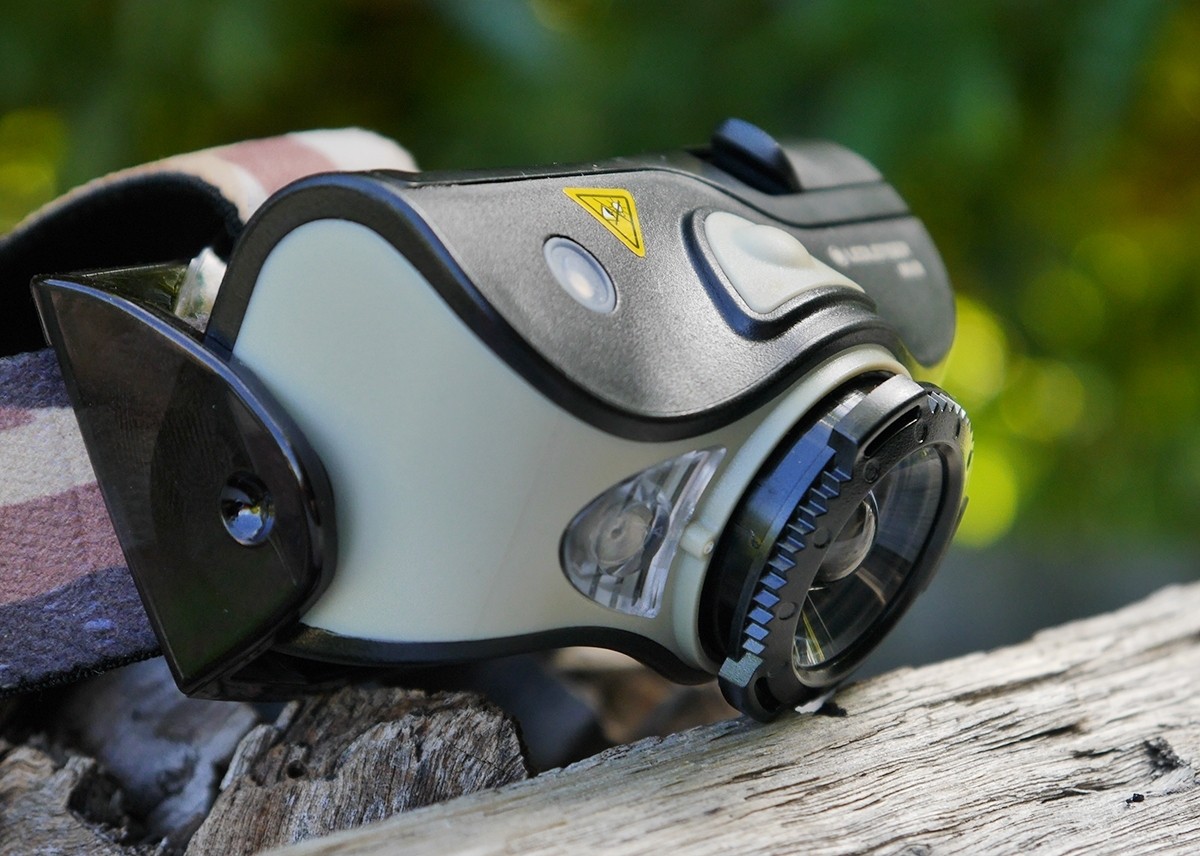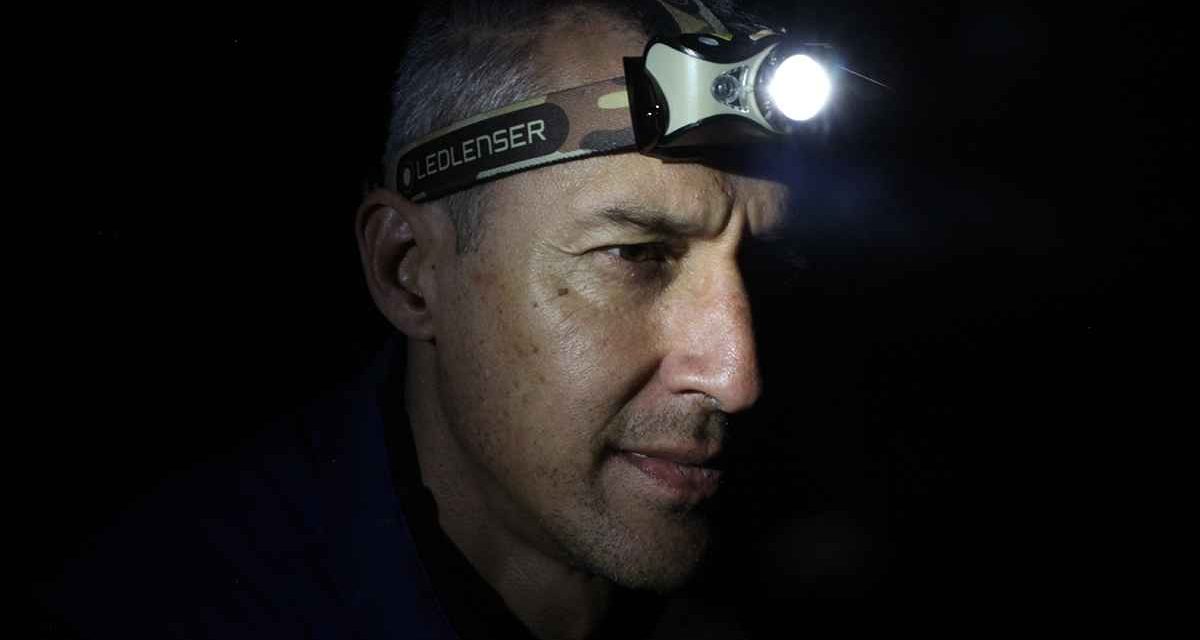Weeks into the COVID-19 lockdown and my mental health is definitely taking a hit. The disappointment of rocking up to my local MTB trails to see laminated notices from the council, cable tied to boom gates, hydro lakes closed to fishing, parks and reserves closed to bushwalkers and not being allowed outside except for essential activities and exercise has been a wilting experience with a new term “quarantine fatigue” being coined.
Then came the excitement of reviewing a LED Lenser headlamp and thinking about what kind of extreme exercise I could do at night with this sucker (since bushwalking and hunting have been canned). Pandemics notwithstanding, equipment testing must go on.
Design & Durability (Rating: 95%)
The headlamp is similar in design in many ways to my Black Diamond and Princeton Tech lamps in that the lamp itself pivots from a cradle to which is attached the headband. The LED Lenser, however, is a bigger heavier unit and comes with a headband which has an extra strap that goes over the head as well as around which is pretty standard for bigger headlamps. The strap material itself is the nicest I’ve used. It’s wide, strong, and soft, almost like neoprene.
An interesting feature of the MH8 is that the unit itself snaps out of the tough plastic cradle, being held in by side indents from which the pivot action takes place. This is to allow the unit to be used as a handheld torch and also allows for the lithium battery to be installed (and disposable spare AAA’s in an emergency). Whilst my other headlamps use grooves as a ratchet, the friction of the pivot indents of the cage into the headlamp body is all that the MH8 uses and it seems quite effective at holding position.
Of course one of the features that LED Lenser helped pioneer and popularise was the lens focusing which allows the user to twist a magnifying lens over the LED to either widen or focus the light beam. Thus, for the same power, one can concentrate the light for a brighter narrower lens, or dim it by effectively widening the angle.
The other noteworthy feature is the power and charging system. A lot of rechargeable headlamps use a rear battery pack which makes the whole lot cumbersome. Most headlamps require a plug-in lead for recharging (e.g. micro USB) or batteries that come out for recharging/replacing. The LED Lenser MH8 uses an innovative magnetic lead that basically sticks to the headlamp (never worry about getting water into the port again) and charges off a USB power supply. A battery level light next to the power switch lets you know if it’s at low, medium or high capacity and the charging status.
Other Features include:
- Transportation Lock – prevents the light from being turned on inadvertently
- Dimmable – seamless adjustment of the luminosity
- Red, Blue and Green Reading Light – LED
- IP-Class IP54 – Protection against water projected in a powerful spray
The materials used for the actual lamp unit are really solid. I have cracked my Princeton Tec in a popular user-identified location, but its plastic doesn’t appear to be as durable as the MH8, and the MH8 is probably even tougher than my Black Diamond which has lasted for years without any wear or tear.
I don’t envisage myself snapping the unit out of the cage to use as a handheld, or to remove the lithium battery since it’s charged from the magnetic port whilst installed so the risk of flexing and cracking the plastic cage removing and reinserting the lamp would be low. A user who snaps the lamp in and out regularly (bending the cage is required to do this) may eventually see a failure in the cage and they may not be replaceable rendering the headlamp just a lamp.

Functionality & Ease of Use (Rating: 90%)
So how good is it? I was jealous of my own kids when last Christmas I bought two of them a couple of LED Lenser lamps that were on sale at my local tool shop and now I get the chance to try one. Of course, I had to sit down with the interesting single pager of hieroglyphics to try and figure out what series of switch presses and holds would do what and this took a couple of goes. Cramming in light levels, discharging profile’s, locks, colours and on and off all with the one switch requires some interesting sequences. Be prepared for a bit of a learning curve and perhaps the odd YouTube video. Think press and hold for a certain number of seconds then a quick double press and ending up with the headlamp going to red when you thought it should go to boost.
Yes, it’s the most complicated headlamp I’ve used, but that’s what you get for having so many features and only one button to rule them all.
Light Functions
- Power – high light output for every situation
- Low Power – economical light for long battery life, glare-free reading and working
- Mid Power – medium light output for every situation
- Boost – short-duration maximum power for more brightness
- Blink – automatic emission of light impulses at regular intervals
The specs rate the battery life as 60hrs on the lowest setting and 7hrs on the high setting. I’ve not done the test because even in iso I’ve got better things to do than watch a headlamp slowly die. I’m going to say based on the specs this lamp is going to do multi-day walks hands down. It’s unlikely that you would ever use the high setting in any bushwalking situation other than wildlife spotting or in an emergency (night navigation). The low setting is more than enough for around camp. Focus it for cooking and pitching a tent, then unfocus for peripheral vision so you’re not tripping over your mates’ guy ropes.
The first test I ran was basically just doing a night walk. I’ve done some night walks and night searches for missing people before and my current headlamps just don’t cut it. They don’t put out enough lumens to see a searchable distance. Basically, if I wasn’t within ten metres of an object of interest or closer I wasn’t going to see it. Realistically for night searches, I need to be able to get out to more like 30-40 metres and this headlamp had no problems.
I was able to identify a rabbit under a bush and pace out the distance to it and this was repeatable between 50-60 metres on the high power (not boost) setting. Boost is interesting – it ramps up to 600lm for about ten seconds, then drops back down. I’m not exactly sure why you would need a flash setting but I do know that last year while cycling in Vietnam on a country road we misjudged sunset and ended up riding in the dark and a flashing headlamp facing backwards on my head gave me some level of comfort that at least someone would wonder what that flashing light was and make some kind of effort to not run it over.
On the night walk in a local original old-growth tee-tree reserve I was easily able to spot features like fence posts and signs out to 100 metres.
The next test I decided to spice things up a little, so I hoisted the mountain bike into the ute and entered the same area which borders the Don River for another essential exercise activity. I wondered what brightness I would need to keep up with a trail ride. It had drizzled just prior to riding and the night was somewhat damp which meant a lot of light reflected back from moisture in the air. Starting with medium light and not a lot of focus (I wanted to see where the trail was heading easily so peripheral vision was desirable) I rolled down the hill and quickly ended up off track even though I knew the area. In an effort to get back on track I hit a windfall branch about thigh width and crashed. Simply didn’t see it. I upped the brightness to maximum and focussed the beam fully and took off again with not much damage taken. The rest of the ride was fantastic. I got super close to a bandicoot, possums and wallabies. Night riding is brilliant.
On the way back up the incline to the car, as I was riding slower, I was able to get away with medium setting and full focus. Full focus does mean panning with the head rather than using just eye movement but it’s not a biggie. I also wanted to test out the 200-metre claim so I stopped on the railway line where I could get a straight long view and I may need to go to Specsavers but I don’t think 200m was doable, possibly due to the misty air. I’m going to say it’s possible but your air would have to be super clear.
Changing brightness settings is a breeze, it’s just basically stepping up within a certain time frame and once the lamp’s been running a few seconds the button acts as on/off. A rapid double press activates boost. One thing I didn’t like was that turning off the lamp and turning it back on again meant having to go through the settings all over again. I like lamps that remember your last setting and return to it when you turn it on again.
One feature the MH8 doesn’t have that I like is holding the power button to dim the light to the desired brightness. I have this with my Black Diamond, and I can dim from maximum to minimum to exactly the setting I want but with the MH8 this isn’t possible. The consolation was I could widen the lens to dim it.
The only other aspect I didn’t like was that I couldn’t tilt it far enough forward and down which was a design issue with where the pivot it located. It’s written in bushwalking lore that thou shalt not blind a fellow walker with thine head illuminators and if I’m a standard corona distance from you, I can’t help but expose your eyes a little to my beam, so I’m sorry. Just cough or sneeze a little and I’ll back off.
The last drawback for me is just the weight. The MH8 weighed in at 141g which is a really big step up from the 81-94g for my lower end lamps. This meant after a while wearing it the weight on the forehead was noticeable. Probably not enough to give me a headache but you can understand why a lot of manufacturers split the weight between the front and back of the head. Obviously, weight is a trade-off with battery size and construction durability being a big part of the total.
Aside from these little gripes, the headlamp is just fantastic and a big step up from what I’ve been using.

What I Like
- The power and the ability to focus the beam. It gets out to the distances I need.
- Battery life rated at 60hrs on low setting and 7 hrs on high beam
- Being able to charge the lithium battery with a magnetic snap-on lead
- The vast array of light settings (white and colour)
- Comfort of the headband
- Tough build
- It takes AAA’s in an emergency
What I Don’t Like
- I can’t tilt the lamp forward and down far enough not to flash others who I might be walking with
- The lamp doesn’t return to the last setting. You have to go through all the settings again to get to full bright
- It’s heavier than I’m used to.
- The 200-metre distance claims are optimistic and rely on a really clear night






Is it really dimmable? I’ve had it for years and never discovered this feature – but I totally agree with you and Olivia about the problems with the instructions. A cryptic crossword is easier to figure out than those instructions.
Now, while this model is still available from Ledlenser (at least in Australia) the headbands seem not to be available any more. A negative strike against Ledlenser if this is the case – selling a headlamp for the price they charge but not keeping headbands in stock for the reasonably predictable life of the product.
I bought this headlamp through a work offer and I appreciate its power while night running. Also the focusing ring is a great idea andI use it a lot.
It doesn’t move on my head and while it’s heavier than my other 2 lamps it’s ok.
The blue and green lights are interesting, if I don’t want to be visible to others whilst running at night I use the green light and I can just see enough on easier mountain paths and yet friends say they hardly notice the light. Cool while running illegally during French confinement rules last year !
Led lenser also do 1000 lumen headlamp I see.
Thanks so much for this review! I bought this headlamp for an Alaskan winter running outside (I was overrunning my Penzel headlamp with way fewer lumens). Anyways – I concur that the instructions are like hieroglyphics and I’ve asked several people to help me interpret them to no avail. But perhaps I was struggling with this because I was thinking that when I turned it off and then back on, it was at my previous setting. I don’t recall it saying anywhere in the manual that it does this… definitely a flaw. But so far, I do really like it. I have yet to get the blue or green light to turn on and don’t know what my issue is there… I just wonder if I’m not pressing the button hard enough (it is rather hard to push with super cold hands that are a norm for me). Do you have any YouTube video recommendations that you stumbled on when you were trying to learn about it? I’m also a little bummed to learn that the 600 lumens *boost* is only a temporary setting. I wanted this headlamp for very well lit dark winter night runs (I’ve already have 4 moose run ins on the trail this year alone), and if it isn’t possible to kick it up to 600 lumens for a predictably-timed run, I’m not sure I want to keep it…